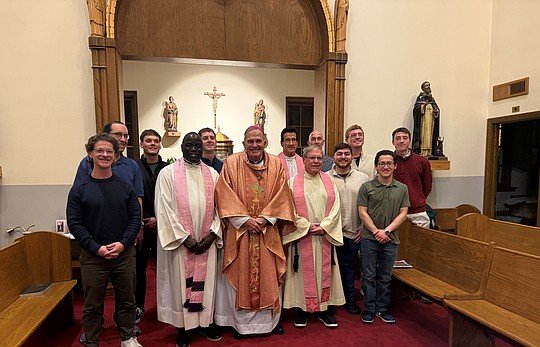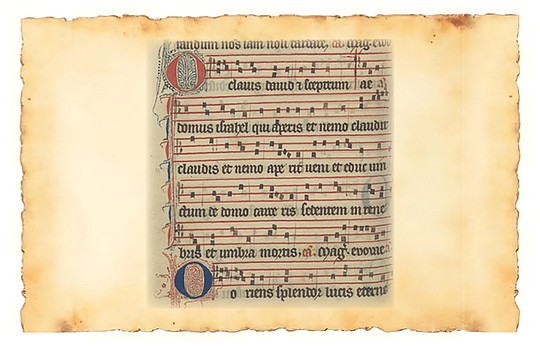Sts. Louis and Zélie: St. Thérèse's parents are models of love and devotion
February 7, 2025 at 12:00 a.m.

OSV News – As the second married couple to be declared saints (along with Sts. Anne and Joachim, the parents of Mary), and the first to be canonized together, Sts. Louis and Zélie Martin offer a model of the vocation to love and holiness that is at the heart of the sacrament of marriage.
By showing how God worked through both their successes and occasional failures as spouses and parents (including of St. Thérèse of Lisieux), the Martins can offer inspiration and hope for countless millions of Catholic couples seeking to live out their faith in the details of everyday married life.
Zélie Guérin was a formidable young woman. Alongside her deep religious faith, the defining feature of Zélie's personality was her determination to succeed in business and to acquire financial independence. Her childhood had been an unhappy one, marked by material hardship. After she was denied entry to the convent, she turned to the art of lacemaking (for which her village of Alençon was famous) to acquire the respectable dowry which her parents' poverty had denied her.
These early experiences had scarred Zélie, leading her to become what would today be called a workaholic, even when she and Louis were financially secure. In a letter written only weeks before her death from cancer in 1877, Zélie notes her continued work at lacemaking and her intention to "go on like that up to the end."
Louis Martin, on the other hand, could never be described that way. The youngest son of a military officer, he lived a prosperous but almost monastic existence as a watchmaker in Alençon after failing in his youthful attempt at a religious vocation (he did not know Latin). Hardworking and introverted by nature, Louis divided his energies between his successful business and an intense religious devotion defined by daily Mass, prayer and pilgrimages. Unlike many other businesses in town, his shop always remained closed on Sunday. Still single in his 30s, it was rumored he had taken a private vow of celibacy.
Louis' mother, concerned about her youngest son's extended bachelorhood, met Zélie Guérin at a class on lacemaking and immediately saw in her a potential match for her son. How this encounter led to the young couple's initial meeting on a bridge in town is unknown. Told by an inner voice that the handsome stranger she encountered on that bridge was to be her future husband (so the family story goes), the ever-energetic Zélie wasted no time fulfilling this prophecy. Their marriage followed within three months, in July 1858.
Louis initially offered Zélie a "Josephite" (that is, celibate) marriage, revealing a spiritual understanding of marriage that was far removed from the domineering relationships in which so many new brides found themselves. Likewise, Zélie's somewhat reluctant acceptance of the offer also shows a religious attitude that made her a natural match for this quiet man. However, their spiritual adviser quickly put an end to this arrangement, and Zélie eventually gave birth to nine children, five of whom survived to adulthood.
Drawn together originally because they recognized in each other what they valued most – namely, a profound faith and the self-discipline required to live it daily – their conjugal life only strengthened the emotional bonds that already united them. As with every marriage, though, these bonds would be tested by the trials and tragedies of married life.
Zélie's strong but solemn personality made it difficult for her to express the deep love she had for her children. Unintentionally, Zélie inflicted the emotional neglect she had suffered as a child upon her own daughter, Marie-Léonie. It was only at the end of Zélie's life that Léonie achieved some degree of reconciliation and peace with her mother. The struggles of Léonie, who eventually became a Visitation sister and whose own cause for sainthood has recently been opened, should put to rest any illusions that either the Martin marriage or their parenting was perfect in every respect. (Indeed, an autobiography by Léonie would perhaps have more than Thérèse's to say about the challenges of love.)
The depth of the love between Louis and Zélie, and the faith upon which it rested, was put to its greatest trial by the cancer from which she would die in 1877. Several years earlier Zélie had seen the first symptoms of illness, beginning with a tumor in her breast. Always reluctant to complain, she ignored her condition and continued her lacemaking schedule and parental duties while the tumor metastasized and spread throughout her body. By the time she sought help in late 1876, her condition was beyond treatment.
Confronted with her terminal diagnosis on the eve of her 45th birthday, with five children and a husband in need of her care, Louis and Zélie fell back upon the same faith that had brought them together and sustained them in their marriage. A pilgrimage to Lourdes (made in June 1877, when travel was almost a torture for her) had no effect on the cancer's spread, despite Louis' great confidence in the healing waters. Zélie, always more clear-eyed than Louis, confessed to her sister-in-law, "I know very well that the Blessed Mother can cure me, but I can't help fearing that she doesn't want to, and I'll tell you honestly that a miracle seems very doubtful to me now."
At her deathbed, both spouses revealed, in their distinctive ways, the deep love and faith upon which they had built their life together. Their daughter, Celine, recalled: "We were all kneeling beside her bed, in order of age, with Thérèse beside me. Our poor dear father could not restrain his grief. As for our mother, she remained calm and self-possessed. She was to die in a truly saintly way, giving us, to the very end, the example of complete self-forgetfulness and most lively faith."
The scene, combining tragedy and sorrow with the comfort and security of a profound faith in God, serves as a miniature of their married life.
Already shattered by her death, Louis was not to be spared his own Calvary, albeit of a very different sort. He gradually retreated from the world, retiring from business to care for his family. In 1886, Louis had his first episode of dementia, wandering alone for four days before being found, no longer delirious but fundamentally changed in personality. His condition worsened until he was placed in an institution, where he would die in 1894.
The last fragment of his writing we possess – a letter to his daughters from 1888, only months before his final descent into dementia – stands as a testimony not only to his character but to that of the wife he had lost and to the great graces he had been given by God through her and their children. He writes: "I want to tell you, my dear children, that I have the urgent desire to thank God and to make you thank God, because I feel that our family, though very humble, has the honor of being among the privileged of our adorable Creator." No final testament could better capture the spirit of this remarkable husband and father.
As the first married couple to be made saints simultaneously, Louis and Zélie Martin can serve as a model for couples seeking to live out the Catholic faith fully amid the pressures of work, children, illness and loss. It was therefore especially fitting that, at the opening of the 2014 extraordinary Synod of Bishops on the Family, their relics were brought to Rome and venerated as part of the opening Mass.
Now a decade past their canonization in 2015, Catholic couples everywhere should continue to get to know these models for their lives and advocates in heaven. Sts. Louis and Zélie Martin, pray for us!
Lance Richey is president of the University of St. Francis in Indiana.
The Church needs quality Catholic journalism now more than ever. Please consider supporting this work by signing up for a SUBSCRIPTION (click HERE) or making a DONATION to The Monitor (click HERE). Thank you for your support.
Related Stories
Monday, December 15, 2025
E-Editions
Events
OSV News – As the second married couple to be declared saints (along with Sts. Anne and Joachim, the parents of Mary), and the first to be canonized together, Sts. Louis and Zélie Martin offer a model of the vocation to love and holiness that is at the heart of the sacrament of marriage.
By showing how God worked through both their successes and occasional failures as spouses and parents (including of St. Thérèse of Lisieux), the Martins can offer inspiration and hope for countless millions of Catholic couples seeking to live out their faith in the details of everyday married life.
Zélie Guérin was a formidable young woman. Alongside her deep religious faith, the defining feature of Zélie's personality was her determination to succeed in business and to acquire financial independence. Her childhood had been an unhappy one, marked by material hardship. After she was denied entry to the convent, she turned to the art of lacemaking (for which her village of Alençon was famous) to acquire the respectable dowry which her parents' poverty had denied her.
These early experiences had scarred Zélie, leading her to become what would today be called a workaholic, even when she and Louis were financially secure. In a letter written only weeks before her death from cancer in 1877, Zélie notes her continued work at lacemaking and her intention to "go on like that up to the end."
Louis Martin, on the other hand, could never be described that way. The youngest son of a military officer, he lived a prosperous but almost monastic existence as a watchmaker in Alençon after failing in his youthful attempt at a religious vocation (he did not know Latin). Hardworking and introverted by nature, Louis divided his energies between his successful business and an intense religious devotion defined by daily Mass, prayer and pilgrimages. Unlike many other businesses in town, his shop always remained closed on Sunday. Still single in his 30s, it was rumored he had taken a private vow of celibacy.
Louis' mother, concerned about her youngest son's extended bachelorhood, met Zélie Guérin at a class on lacemaking and immediately saw in her a potential match for her son. How this encounter led to the young couple's initial meeting on a bridge in town is unknown. Told by an inner voice that the handsome stranger she encountered on that bridge was to be her future husband (so the family story goes), the ever-energetic Zélie wasted no time fulfilling this prophecy. Their marriage followed within three months, in July 1858.
Louis initially offered Zélie a "Josephite" (that is, celibate) marriage, revealing a spiritual understanding of marriage that was far removed from the domineering relationships in which so many new brides found themselves. Likewise, Zélie's somewhat reluctant acceptance of the offer also shows a religious attitude that made her a natural match for this quiet man. However, their spiritual adviser quickly put an end to this arrangement, and Zélie eventually gave birth to nine children, five of whom survived to adulthood.
Drawn together originally because they recognized in each other what they valued most – namely, a profound faith and the self-discipline required to live it daily – their conjugal life only strengthened the emotional bonds that already united them. As with every marriage, though, these bonds would be tested by the trials and tragedies of married life.
Zélie's strong but solemn personality made it difficult for her to express the deep love she had for her children. Unintentionally, Zélie inflicted the emotional neglect she had suffered as a child upon her own daughter, Marie-Léonie. It was only at the end of Zélie's life that Léonie achieved some degree of reconciliation and peace with her mother. The struggles of Léonie, who eventually became a Visitation sister and whose own cause for sainthood has recently been opened, should put to rest any illusions that either the Martin marriage or their parenting was perfect in every respect. (Indeed, an autobiography by Léonie would perhaps have more than Thérèse's to say about the challenges of love.)
The depth of the love between Louis and Zélie, and the faith upon which it rested, was put to its greatest trial by the cancer from which she would die in 1877. Several years earlier Zélie had seen the first symptoms of illness, beginning with a tumor in her breast. Always reluctant to complain, she ignored her condition and continued her lacemaking schedule and parental duties while the tumor metastasized and spread throughout her body. By the time she sought help in late 1876, her condition was beyond treatment.
Confronted with her terminal diagnosis on the eve of her 45th birthday, with five children and a husband in need of her care, Louis and Zélie fell back upon the same faith that had brought them together and sustained them in their marriage. A pilgrimage to Lourdes (made in June 1877, when travel was almost a torture for her) had no effect on the cancer's spread, despite Louis' great confidence in the healing waters. Zélie, always more clear-eyed than Louis, confessed to her sister-in-law, "I know very well that the Blessed Mother can cure me, but I can't help fearing that she doesn't want to, and I'll tell you honestly that a miracle seems very doubtful to me now."
At her deathbed, both spouses revealed, in their distinctive ways, the deep love and faith upon which they had built their life together. Their daughter, Celine, recalled: "We were all kneeling beside her bed, in order of age, with Thérèse beside me. Our poor dear father could not restrain his grief. As for our mother, she remained calm and self-possessed. She was to die in a truly saintly way, giving us, to the very end, the example of complete self-forgetfulness and most lively faith."
The scene, combining tragedy and sorrow with the comfort and security of a profound faith in God, serves as a miniature of their married life.
Already shattered by her death, Louis was not to be spared his own Calvary, albeit of a very different sort. He gradually retreated from the world, retiring from business to care for his family. In 1886, Louis had his first episode of dementia, wandering alone for four days before being found, no longer delirious but fundamentally changed in personality. His condition worsened until he was placed in an institution, where he would die in 1894.
The last fragment of his writing we possess – a letter to his daughters from 1888, only months before his final descent into dementia – stands as a testimony not only to his character but to that of the wife he had lost and to the great graces he had been given by God through her and their children. He writes: "I want to tell you, my dear children, that I have the urgent desire to thank God and to make you thank God, because I feel that our family, though very humble, has the honor of being among the privileged of our adorable Creator." No final testament could better capture the spirit of this remarkable husband and father.
As the first married couple to be made saints simultaneously, Louis and Zélie Martin can serve as a model for couples seeking to live out the Catholic faith fully amid the pressures of work, children, illness and loss. It was therefore especially fitting that, at the opening of the 2014 extraordinary Synod of Bishops on the Family, their relics were brought to Rome and venerated as part of the opening Mass.
Now a decade past their canonization in 2015, Catholic couples everywhere should continue to get to know these models for their lives and advocates in heaven. Sts. Louis and Zélie Martin, pray for us!
Lance Richey is president of the University of St. Francis in Indiana.
The Church needs quality Catholic journalism now more than ever. Please consider supporting this work by signing up for a SUBSCRIPTION (click HERE) or making a DONATION to The Monitor (click HERE). Thank you for your support.










